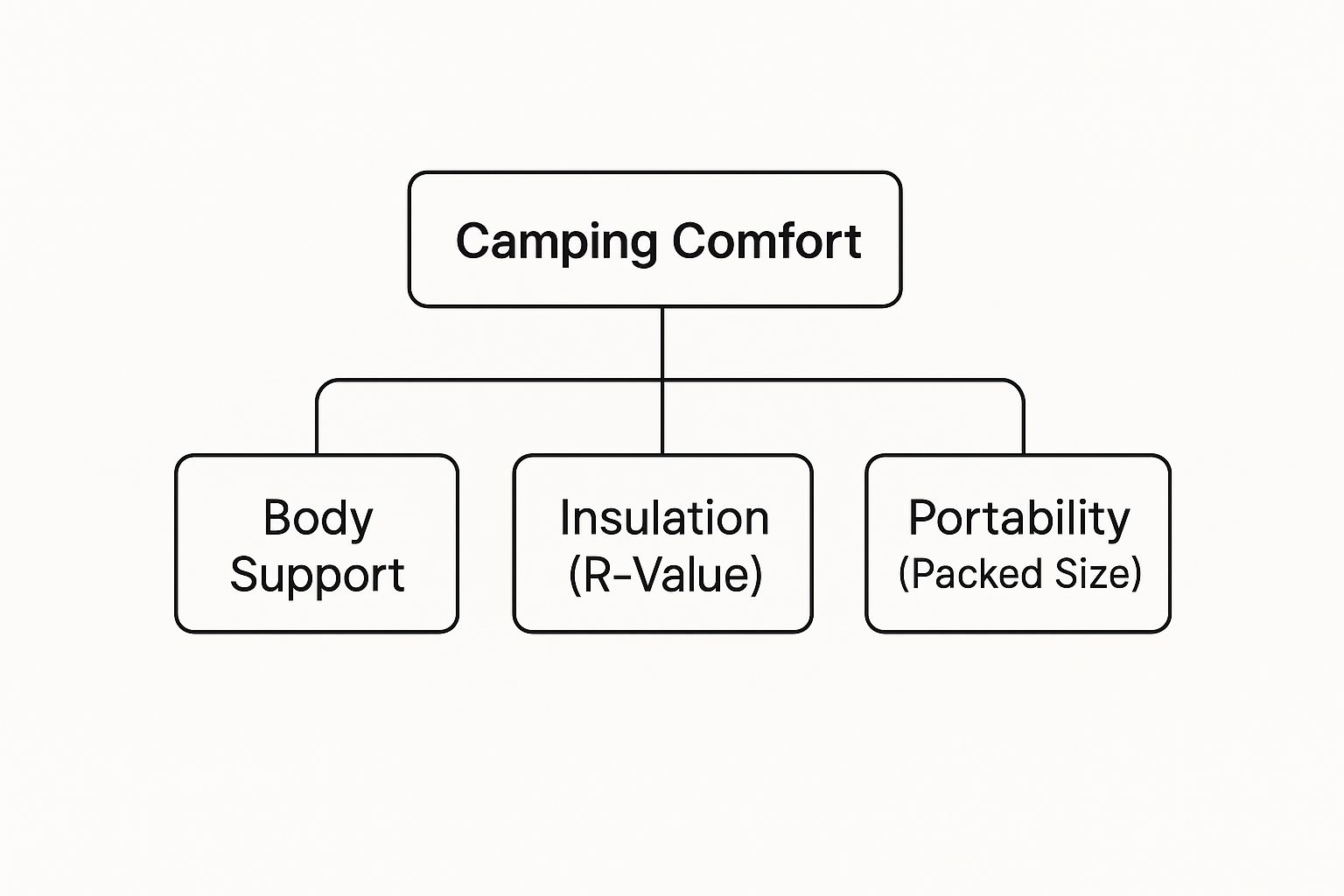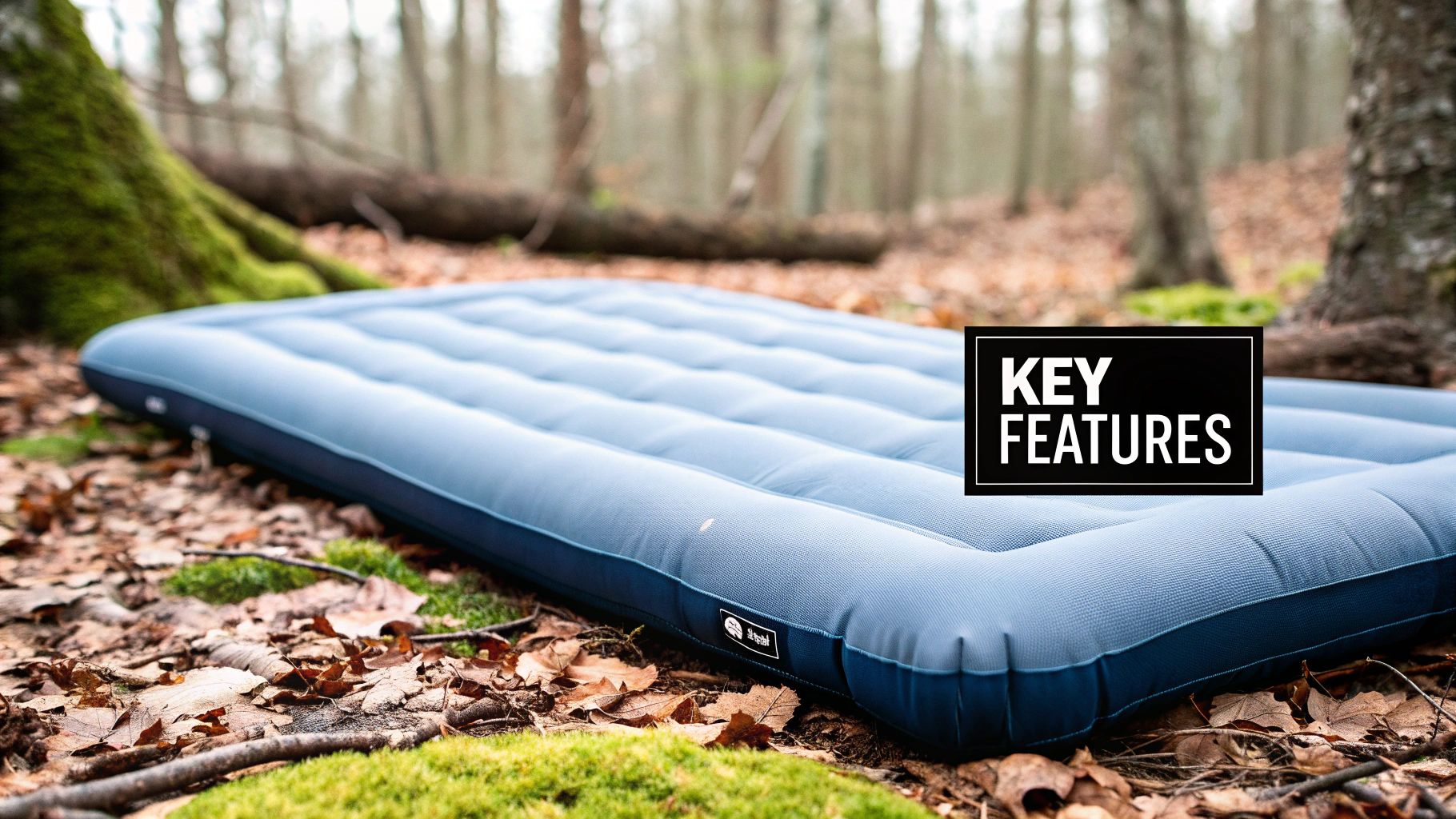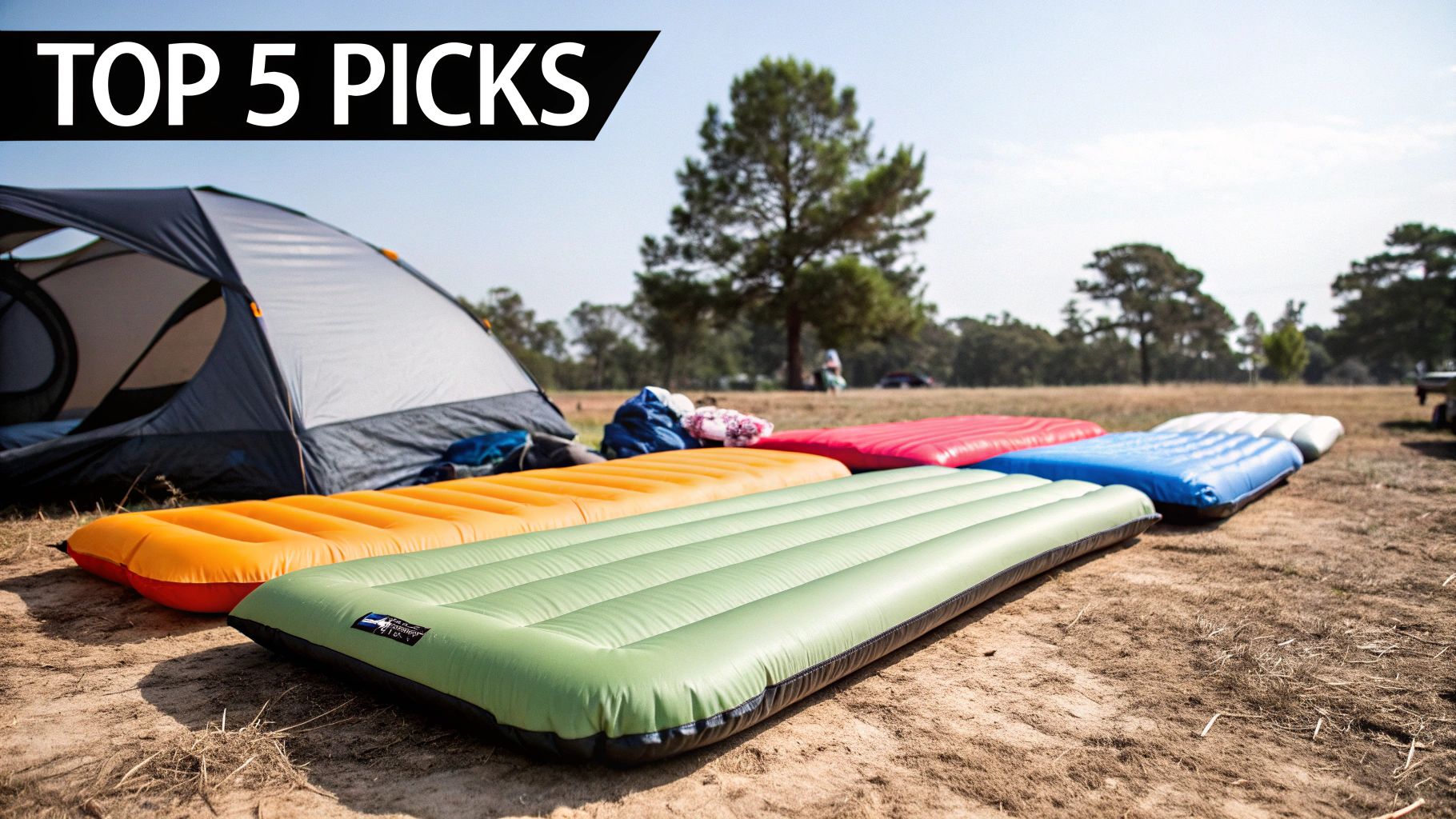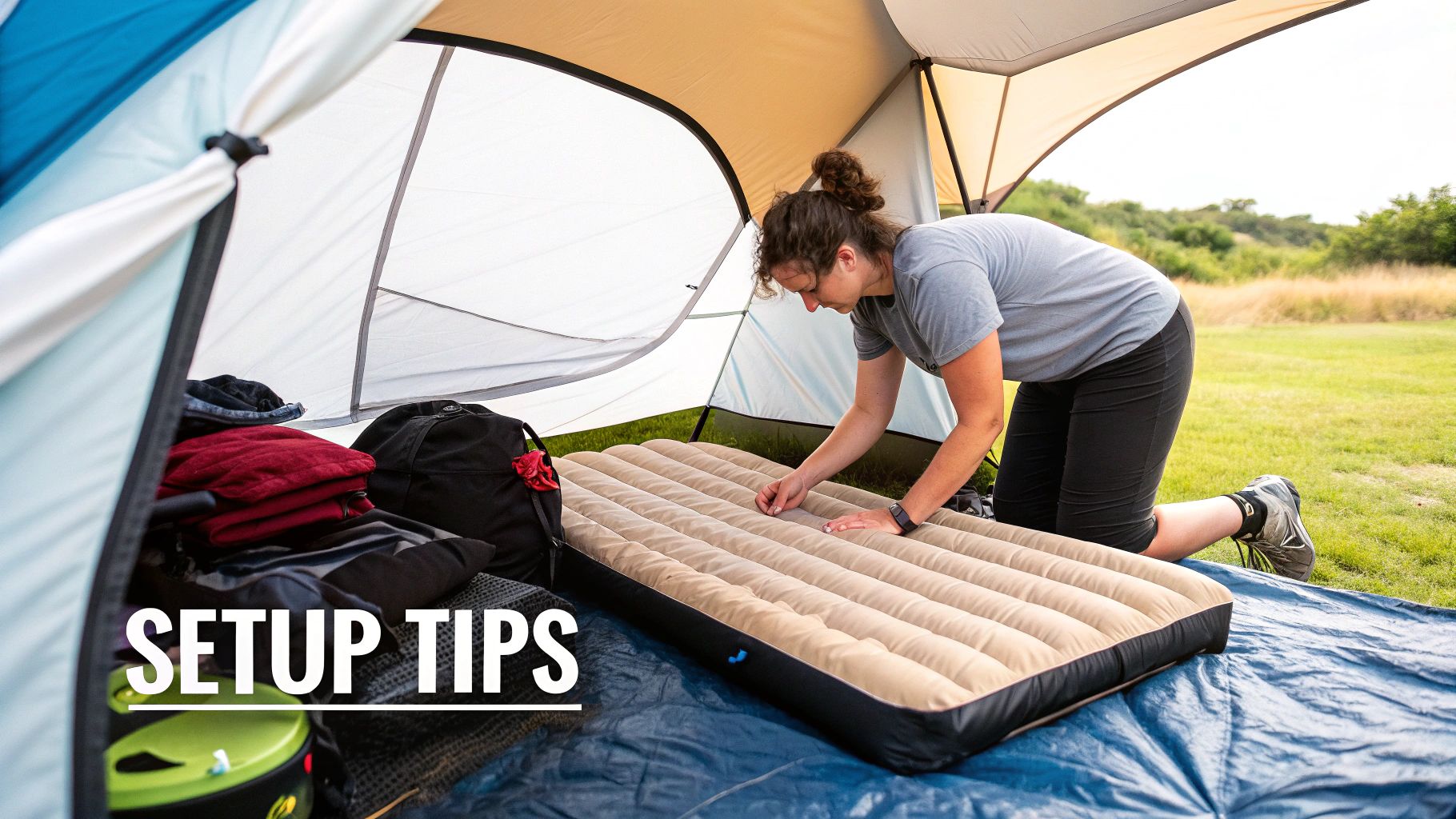With over 10,000 orders
With over 10,000 orders

Picking the right inflatable camping mattress isn't just about finding something soft to lie on. It's about striking the perfect balance between comfort, warmth, and portability for the kind of adventures you go on. If you’re a car camper, you can afford the luxury of a thick, plush mattress. But if you're a backpacker, every single ounce and cubic inch matters, so a lightweight, compact pad with a high warmth-to-weight ratio is your holy grail.
The trick is to figure out what your number one priority is before you even start looking. Is it cloud-like cushioning or a ridiculously small pack size?
Choosing the right inflatable camping mattress is way more than just dodging a few rocks under your tent. It's one of the most critical gear decisions you'll make, directly impacting how well you sleep and how much energy you have for the next day's hike. A good mattress is your shield against the cold, hard ground, giving you both insulation and support.
This choice almost always comes down to a trade-off between three key elements.

As you can see, body support, insulation, and portability are all connected. When you pull on one, you usually have to give a little on another.
Every camper has their own unique "comfort triangle." Your perfect mattress is the one that best fits your priorities.
A big, heavy mattress might feel like sleeping on a cloud—perfect for a car camper who just pulls it out of the trunk. But its weight and bulk make it a non-starter for a backpacker who needs something that practically disappears in their pack. On the flip side, an ultralight pad might be a backpacker's dream for portability, but it probably won't offer the same level of cushioning.
Understanding this trade-off is the first step to making a smart purchase. Instead of searching for one single "best" mattress, the goal is to find the best inflatable camping mattress for you.
To help you get a head start, this table quickly matches key mattress features to the type of camper who will appreciate them most. Think of it as a cheat sheet to help you focus on what's important as we dive into the nitty-gritty of R-values, materials, and inflation methods.
| Feature | Why It Matters | Prioritized By |
|---|---|---|
| High R-Value | Provides crucial insulation to keep you warm and stop the cold ground from stealing your body heat. | Cold-Weather & 3-Season Campers |
| Increased Thickness | Offers better cushioning and support, which is a game-changer for side sleepers. | Car Campers & Comfort Seekers |
| Low Weight & Packed Size | Reduces the burden on your back and frees up precious space in your pack for other essentials. | Backpackers & Thru-Hikers |
This little guide should give you a solid foundation. Now, let's get into the details that will help you find that perfect pad.
When you start digging into inflatable camping mattresses, you'll see two specs mentioned constantly: R-value and thickness. Getting a handle on these two is the secret to unlocking a truly great night's sleep in the wild. They’re the dynamic duo fighting back against the cold, hard ground.
Think of R-value as your mattress's superpower against the cold. It’s a measure of how well it resists heat flow—or, more simply, how good it is at stopping the chilly ground from zapping all your body heat. This heat-sucking process is called conduction, and it’s the number one reason you feel cold when sleeping outside.
Without good insulation, the ground acts like a giant ice cube, relentlessly pulling warmth away from you all night long. This is why you can be shivering on a basic air mattress even on a mild night. It's not the air temperature that gets you; it's the ground.
So, what do those R-value numbers actually mean for you? Thankfully, it's a standardized rating, which makes comparing different pads a breeze. The logic is simple: a bigger number means more insulation and a warmer night.
Here’s a rough breakdown to guide you:
Choosing the right R-value isn't just about comfort; it's about making sure you get a safe and restorative night's sleep, no matter what the weather does.
While R-value is all about staying warm, thickness is your key to pure, cushioned comfort. A thicker mattress obviously provides more padding, but its real job is to prevent you from "bottoming out."
This is a make-or-break feature, especially if you're a side sleeper. Your hips and shoulders create major pressure points that can easily push right through a thin pad and hit the unforgiving ground. The result? A night of tossing, turning, and waking up sore.
A thicker mattress—we’re talking three inches or more—creates enough space for your hips and shoulders to sink in comfortably without ever touching the ground. This keeps your spine properly aligned and helps you wake up feeling like you actually slept.
Ultimately, R-value and thickness work as a team. You need the R-value for warmth, but you need the thickness for the kind of body-cradling support that makes sleeping on the ground feel surprisingly luxurious. Finding the right balance between the two is how you find your perfect backcountry bed.
An inflatable mattress is only as good as the stuff it’s made from. These fabrics are the only thing standing between you and the cold, hard ground, so it pays to know what you're looking for. The two big players you'll see are Polyvinyl Chloride (PVC) and Thermoplastic Polyurethane (TPU) coated nylon or polyester.

Think of a heavy-duty PVC mattress like the big, knobby tires on a 4x4. It's incredibly tough, resists scrapes and punctures, and is usually cheaper. This makes it a fantastic choice for car camping when you can just toss it in the trunk. The trade-off? It’s heavy, bulky, and can get a bit stiff and crackly when the temperature drops.
On the other hand, a TPU-coated nylon or polyester mattress is more like a sleek, lightweight running shoe. It's way lighter, stays flexible in the cold, and packs down to almost nothing. This is exactly why it's become the gold standard for backpackers and anyone counting every ounce.
Beyond the basic material, you’ll often see a number followed by a "D," like 75D Polyester. This is the fabric's denier, which is just a fancy way of measuring the thickness of the individual threads. A higher denier number usually means a tougher, more puncture-resistant fabric, though it might add a little extra weight.
It's not just about the fabric, though. The quality of the seams holding the whole thing together is just as important. Good, strong welds are what prevent those frustrating, slow leaks that leave you on the ground by 3 AM.
And don't forget the valve! A well-made, sturdy valve is easier to use and much less likely to leak. Getting a handle on these details helps you see past the marketing hype and judge how a mattress will actually hold up in the wild. For a more detailed breakdown, you can check out our complete guide on how to choose the best sleeping pad.
After a long day on the trail, the last thing you want is a workout just to set up your bed. How you inflate your mattress can be the difference between collapsing into a comfy bed and a dizzying, frustrating chore. Thankfully, we've moved past the days of just huffing and puffing into a tiny valve.
Modern sleeping pads come with a few clever inflation options. The right one for you really just boils down to your personal camping style.

Of course, you can still use good old-fashioned lung power. But it's got a big drawback: every breath you exhale into your pad introduces moisture. Over time, that can lead to a funky mess of mold and mildew growing inside, which is a great way to ruin an expensive piece of gear.
A much better way to go is the pump sack. This is a simple but brilliant invention—a lightweight, waterproof bag that connects to your mattress valve. You just open it up, trap a big gulp of air, seal the top, and squeeze.
It's amazing how well they work. A standard pump sack can fill a pad in just 4-6 bagfuls. It’s quick, saves your breath, and most importantly, keeps all that damaging moisture out. Plus, many of them double as a waterproof stuff sack.
Now, if you're car camping and convenience is king, you can't beat a battery-powered pump. These little gadgets do all the work for you, inflating even a massive queen-sized mattress in a minute or two. As integrated electric pumps and firmness controls get more common, they’re becoming a go-to for many. If you're curious, it's worth exploring the latest trends in the air mattress industry.
So, what’s the best method? It’s all about what kind of trip you’re on. A backpacker counting every ounce is going to love a pump sack for its low weight and dual-purpose design. It’s the sweet spot between efficiency and packability.
On the other hand, a family setting up camp with multiple beds will be incredibly thankful for the push-button ease of an electric pump.
Here’s a quick breakdown to help you decide:
If you're a backpacker, you live by a simple mantra: every ounce counts. This is where the real challenge of picking an inflatable camping mattress kicks in. You're constantly torn between the promise of a good night's sleep and the hard reality of lugging that comfort up a mountain on your back.
This tug-of-war has pushed designers to get incredibly creative. Imagine a sculptor, carefully chipping away at a block of marble. The goal is to carve off every last bit of unnecessary material, leaving behind a lighter, more efficient shape. That's precisely why so many ultralight pads have a mummy or tapered shape—they trim away fabric at the head and feet where you just don't need the extra width.
These smart design tweaks make a massive difference. We're talking about shaving off several ounces and shrinking the packed size, all without losing support where it matters most. This is the art of backcountry engineering in a nutshell: getting maximum performance out of minimal mass.
So, how do you know if a few extra ounces are worth the burn? It really boils down to your personal priorities and what kind of trip you have in mind. A slightly heavier pad might offer a huge boost in warmth or cushioning, which can be an absolute lifesaver on a chilly or particularly bumpy trip.
A good way to think about it is to consider the "cost" of comfort in ounces:
The real goal is to find a mattress that makes your adventure better, not one that just weighs you down. It’s a personal calculation, and getting a handle on this trade-off is the key to choosing the right gear.
For anyone looking to get into the nitty-gritty of pad design, our guide on the features of an inflatable sleeping pad breaks it down even further. At the end of the day, the best choice is simply the one that lets you rest well so you can hit the trail with plenty of energy.
You’ve invested in a great inflatable camping mattress, and now you want it to last. Let's be honest, nothing ruins a trip faster than a deflated mattress in the middle of the night. A little bit of know-how in care and repair will protect your gear and keep you comfortable for countless adventures to come.

When you get home from a trip, don't just shove your pad back in the closet. Take a few minutes to wipe it down with a damp cloth and a bit of mild soap. Prop it up somewhere with the valve open and let it air dry completely. This simple habit stops grime and moisture from breaking down the fabric or inviting mildew.
How you store your mattress matters. Keeping it crammed in its stuff sack for months on end is a bad idea, as it can damage the insulation and create weak spots in the fabric. A much better approach is to store it loosely rolled or laid out flat under a bed, always with the valve open.
Of course, even the most careful camper can end up with a puncture. Finding a pinhole leak can feel impossible, but I've got a trick for you. Inflate the mattress and submerge sections of it in a tub or calm lake, looking for a tell-tale stream of bubbles. No water around? Just mix up some soapy water, sponge it onto the pad, and watch where the bubbles form.
Once you’ve found the leak, dry the area and circle it with a marker so you don't lose it. Grab your patch kit (you do have one in your pack, right?), clean the surface again, and follow the instructions to apply the patch. A solid, airtight seal is what you're after.
These basic maintenance skills are what separate seasoned campers from rookies. As more people discover the outdoors, the market for gear like this is booming—it's projected to hit $11.93 billion by 2033! That means more innovation and even better products are on the horizon. Learning to care for your gear not only saves you money but also ensures you know how to get some ood Zzz's during camping, which is what it's all about.
Picking out a new sleeping pad always brings up a few questions. It makes sense—you're investing in your comfort and warmth in the wild. We get these all the time, so let's clear up some of the most common ones.
This is probably the most important question, and the answer comes down to one thing: ground temperature. You need to match your pad's insulation to the conditions you actually camp in.
We've all been there—waking up in a crumpled heap against the tent wall. The simplest fix starts before you even set up: find the flattest ground you possibly can. Even a slight slope can send you sliding.
Beyond that, many modern pads have textured top fabrics that grip your sleeping bag. If yours is on the slick side, here’s a classic backpacker trick: lay down a few thin, squiggly lines of silicone seam sealer on the top surface. Once it dries, you’ll have invisible, grippy stripes that hold you in place all night long.
Pro Tip: Less is more with the silicone. You don't need to coat the whole pad. A few wavy lines across the torso and hip area will do the job without you even feeling them.
It might seem like an easy, cheap solution, but please don't do it. A standard air mattress from the spare bedroom is the worst possible choice for camping. The biggest reason? It has zero insulation. That's an R-value of 0. The air inside just gets cold, and the ground will literally suck the warmth right out of you.
They’re also heavy, bulky, and made from materials that can’t handle the sticks, rocks, and general roughness of a campsite. They puncture easily. A proper camping mattress is lighter, tougher, and designed specifically to keep you warm. It’s a piece of gear that’s absolutely critical for a safe and comfortable night outdoors.
At TREKOLOGY, we design gear that solves these real-world camping problems. Our sleeping pads are engineered to give you the best possible rest on your adventures, because a great day on the trail starts with a great night's sleep. Find your perfect camping mattress at Trekology.com.
{"one"=>"Select 2 or 3 items to compare", "other"=>"{{ count }} of 3 items selected"}
Leave a comment